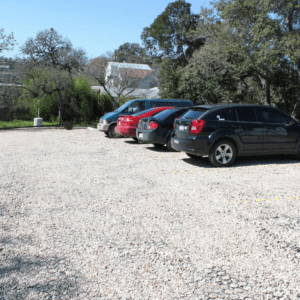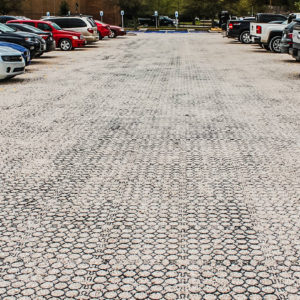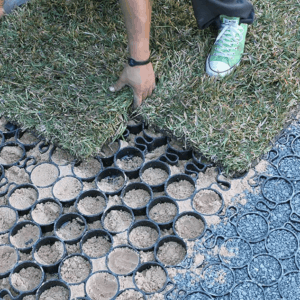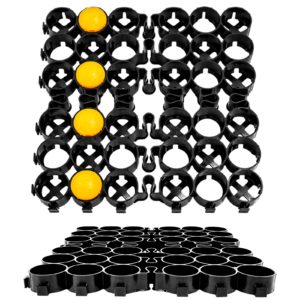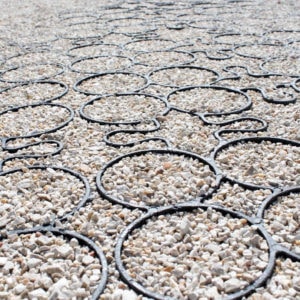permeable pavers Posts
Permeable pavers use a combination of interlocking grids that are laid over a prepared subsurface and one of several fill materials, such as gravel or crushed limestone. Once the fill material is compacted into the grids, it creates a 100% permeable, strong, durable parking surface that is virtually maintenance free.
A parking surface made from permeable pavers requires very little ongoing maintenance, which reduces long-term costs.
Permeable Paver systems have many residential, commercial and industrial applications such as:
- Stormwater management
- Dust control
- Flood mitigation
- Driveways
- Commercial parking lots
- Walkways
- Patios
- Stormwater detention
- and more.
Reduce the Need for Dust Palliatives with Permeable Pavers
Dust on construction sites and large commercial lots can cause many different problems for everyone working in the area. Work sites often see a lot of dirt and pulverized gravel, and the amount of dust that kicks up into the air from heavy vehicles and foot traffic can become so great that it impairs vision […]
How Permeable Pavers are Improving Public Parks
When you think of permeable pavement, you might envision parking lots or sidewalks made from material like permeable asphalt, concrete, or pavers. Parks can also benefit from permeable pavers. In fact, one type of permeable paver is able to improve parks in ways that other types can’t. Let’s review the permeable paver that can have […]
Why TRUEGRID is a Great Choice for Your RV Parking
If you’ve ever owned an RV, you know that having a dedicated parking space is preferable to parking it on the street or in your driveway. RVs are generally too big to fit in a garage and heavy enough to leave indentations and tracks in your yard. Of course, you might be the owner of […]
Never Waste Time or Money on Gravel Lot Maintenance Again
If you were to take a tour of every parking lot in America, you’d find that while most of them are made from concrete or asphalt, there is a very large portion of parking lots built from gravel. Gravel lots serve a very important purpose, mostly that they are the cheapest parking solution you’ll find […]
How to Prevent Gravel Parking Lot Failure with Grid Gravel Stabilizers
Gravel parking lots aren’t the most common type of parking lot you’ll find adjacent to most businesses, but they are practical in some scenarios. Gravel parking lots are typically cheaper than asphalt or concrete parking lots, making them a popular choice for smaller businesses or temporary parking solutions. One of the biggest drawbacks of using […]
Permeable Pavers vs. Non-Permeable Pavers: What Type Should You Use?
Pavers are such a convenience, it’s hard to imagine living without them. Anywhere we want to frequent or travel, pavers make it much easier. Pavers serve a basic yet vital role in helping us get from point A to point B without getting too messy along the way. They provide us with a place to […]
Grass Reinforcement Grid Pavers are the Best Low-Traffic Paving Solution
When it comes to paving small, residential areas, heavy-duty paving solutions aren’t always required. Instead of laying down expensive asphalt or concrete, it’s often a much more efficient idea to go with an alternative that’s both lightweight and cheaper to install. This doesn’t however, mean that you have to sacrifice durability or length-of-life when it […]
The Complete Guide to Plastic Pavers
Creating an area in your business that can handle everything from a toddler’s walk to a large commercial vehicle is a daunting task. Most engineers and architects immediately turn to traditional materials, such as concrete and asphalt. But the same old paving methods are many. These materials may require regular maintenance, cause flooding, pollutant runoff, […]
Permeable Grid Pavers vs. Pervious Concrete
Which is the Best Choice for Your Paving Project Developers, architects and civil engineers face a critical task. They need to provide enough parking and surface storage for their projects, but in an environmentally conscious way. This requires… Using paving surfaces that rainwater can infiltrate instead of running off Using environmentally friendly materials Traditional paving […]
Pervious vs. Impervious Pavement: What’s the Difference and Which is Better?
There are two primary types of pavement: pervious and impervious. Pervious pavement is designed to let water naturally seep through it and go down into the soil beneath. Impervious pavement does not allow water to seep through it. Instead, with impervious pavement, water runs off into storm drains that are lined along the road or […]




